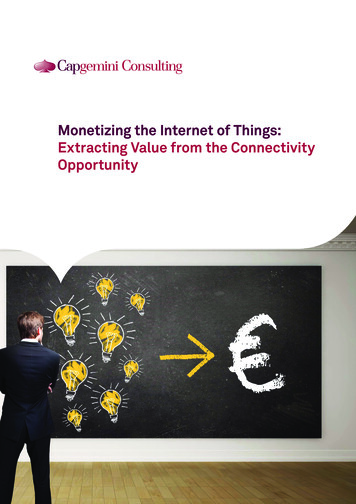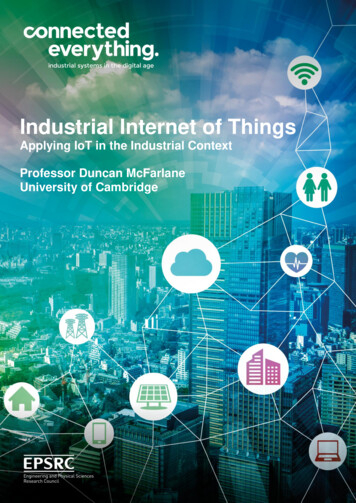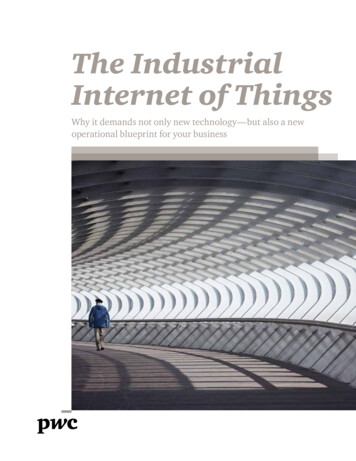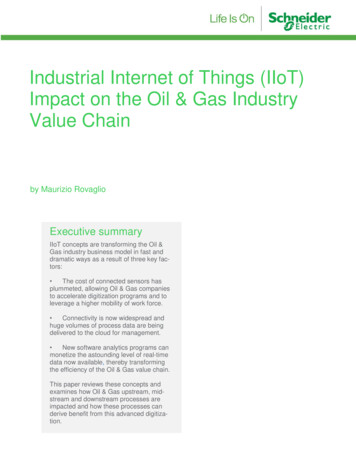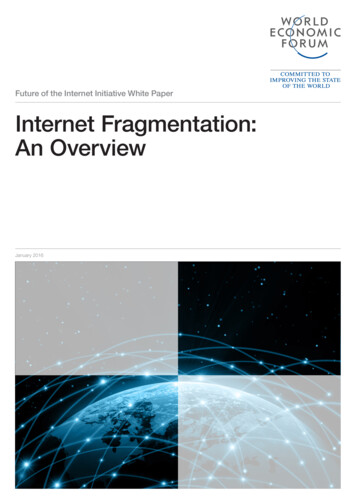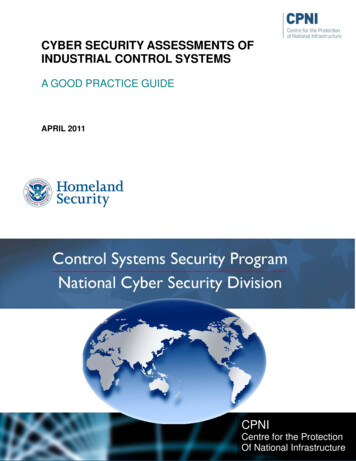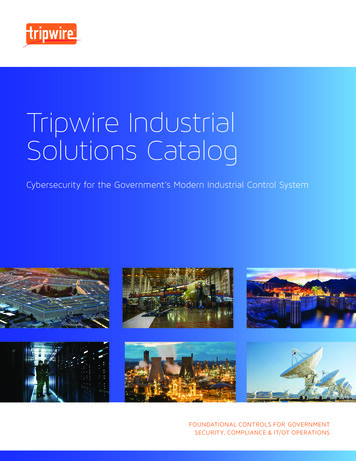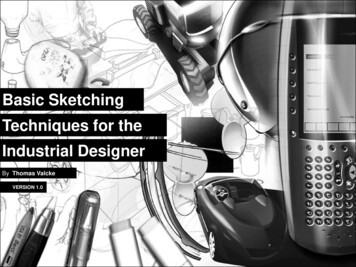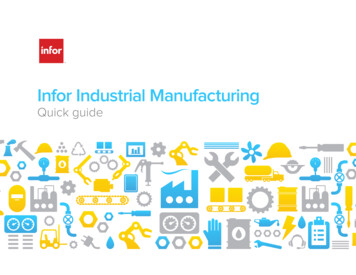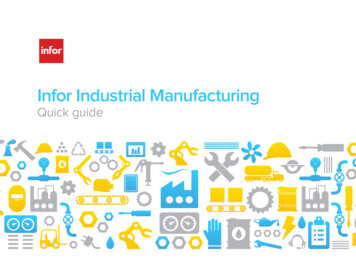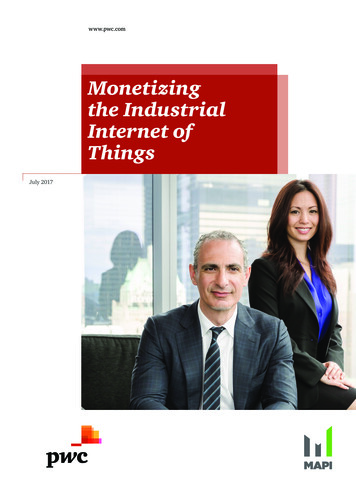
Transcription
www.pwc.comMonetizingthe IndustrialInternet ofThingsJuly 2017
ContentsIntroduction1Enter the IoT race (it may no longer be optional)3Define the IoT value proposition: what do you and your customers want?6Create IoT business models to deliver–then capture–value10IoT products and services development and deployment: Questions to consider15About the PwC/MAPI IoT Business Model Survey16Monetizing the Industrial Internet of Thingsii
IntroductionThe expanding world of connected things Each newsurprising application of a connected device—a carcommunicating with a traffic light?–serves as a reminderthat, given investments and a potential market, nearlyanything could become part of the Internet of Things(IoT). But should it? And, if so, why and how? This isthe crux of the issue for manufacturers. With hundredsof analog products and many more thousands of stillmute touch points inside the business and throughout itsnetworks, being smart about where next to apply IoT—the embedding of an Internet-connected, data-gatheringdevice into a product—is not a simple task. At the sametime, unease over cybersecurity risks, deployment costs,and data talent shortages, as well as the potential to addvalue, weigh on deliberations.Meanwhile, IoT continues its inexorable growth spurtand is growing on two parallel tracks: consumer IoT andindustrial IoT (IIoT). Consumer IoT has already becomean expected and conspicuous feature in consumerproducts, such as wearables emitting biometric data. IIoTencapsulates applications within industrial operations(such as robots talking to one another) as well as fieldservices (think wind turbines signaling a need for repairbefore a breakdown happens). One estimate places thenumber of all connected things globally (e.g., smartphones, embedded sensors, actuators, machinery,vehicles, cameras, radar systems, drones, to name a few)at 8.4 billion in 2017. Two-thirds of connected things areconsumer IoT devices, and about one-third are businessand IIoT (e.g., manufacturing equipment, smart utilities,intelligent oil fields, and smart buildings). That number isprojected to exceed 20 billion by 2020. Put another way,the global population of connected things has alreadyeclipsed the world’s human population.¹Manufacturers in hot pursuit of IoT commercializationAs manufacturers ramp up operational IIoT initiatives(smart factories and connected field services) and supplychains, they are also achieving cost-cutting efficiencies.And, as IIoT-related costs of components, communicationsand data collection, storage, and analysis continueto decline (and functionalities increase) IIoT fencesitters may well become adopters. 5G mobile networkdeployments alone are estimated to enable 3.4 trillionin economic output by 2035 in the global manufacturingsector.² Given the tremendous changes in technologyafoot, manufacturers are hunting for ways to monetizeIIoT through revenue-generating products and services—or to differentiate their core product and servicesofferings in an increasingly converging or commoditizingmarketplace.³ IoT start-ups, too, are drawing attention,with venture capital investment reaching 2.5 billionin US companies developing IoT products and services,roughly doubling the amount invested in 2012, accordingto PwC/CBI Insight MoneyTree report data.⁴At the crux of a successful IoT strategy are sustainableand scalable IoT-centric business models that candemonstrate returns on investments in time, talent,and capital. Manufacturers are finding that they needto work on numerous fronts and collaborate with a hostof (often new) players to commercialize IoT throughrevenue-generating offerings and to improve internalproductivity and collaboration. Companies need todiscern what data customers want (and will pay for) todecide on which sensors or communication protocols, forexample, best suit their product and their customer. IoT isprompting manufacturers to form a new mindset aroundservicing clients.Monetizing the Industrial Internet of Things1
Key findings of the PwC/MAPI IoT surveyTo get a better picture of how—and why—manufacturers are pursuing IoT initiatives to spur new sources of revenue orlead to customer retention efforts or “stickiness,” PwC and the Manufacturers Alliance for Productivity and Innovation(MAPI) surveyed US-based manufacturers. Key findings include: IoT deployments are accelerating: 38% of manufacturers are now offering IoT-driven products and services; anadditional 48% are currently in the process of developing them About half of manufacturers (47%) currently offering IoT products and services are selling customer-managed IoTplatforms (i.e., selling a bundling of product and IoT service, related data-gathering and analysis technology, andsoftware) Over the next five years, manufacturers expect that the revenue driven by IoT-based products and services willincrease by an average 10% of total company revenue The most common reasons manufacturers offer IoT-driven products and services are: 1) competitive pressures; 2)prospects for new revenue and return on investment; and 3) customer demand Only 14% of manufacturers surveyed say they have created go-to-market IoT strategies, and roughly half are inthe creation process, suggesting that some companies are offering IoT products without a clear strategy to marketthose productsWhat our findings tell usFor those looking to advance their position in the IoT race, our findings inform five overarching recommendationsmanufacturers should consider.1. Identify do-able, realistic entry points (or expansion plans) into the IoT products and services market— yourcompetitors likely already have a strategy.2. Define and demonstrate how IoT products and services create value for your customers and your company. Beagile at proof-of-concept stage and be prepared to move swiftly past early challenges.3. Develop effective IoT go-to-market strategies to effectively support your IoT products and services offerings.4. Create scalable and future-proof IoT business models and promote an entrepreneurial culture to develop them.5. Learn from your products and your customers to improve, accelerate, and scale up your IoT productsand services.Monetizing the Industrial Internet of Things2
Enter the IoT race(it may no longerbe optional)Monetizing the Industrial Internet of Things3
According to our survey, nearly 90% of industrialmanufacturers are either currently offering IoT-drivenproducts and services to customers or are in the processof developing them. This compares to a 2015 PwCsurvey of US manufacturers which found only 69% ofmanufacturers had either been embedding sensors inproducts that enable end-users/customers to collect thedata or planned to do so in the future.⁵ Arguably thegreatest value may be created, however, through theanalytics and insights delivered to the organization (andits customers) leveraging collected data. As with anyemerging technology, some enterprises will grapple withentry timing, unsure whether they might be too late—oreven too early—in their adoption strategies.This is easy to understand. There are myriadconsiderations. IoT products cover a vast breadth ofsophistication. Consider Rolls Royce’s IoT-driven “enginehealth management,” an industrial-use case that monitorsthousands of jet engines globally using sensors andlive satellite feeds to gather performance data usedfor proactive maintenance.⁶ But IoT can smarten upsimpler, consumer-case, applications, too. Take Memphis,Tennessee-based Hunter Fan Company, which updatedthe 103-year-old electric fan by equipping it with sensorsfor an automated home solution which allows control ofthe fan through a hand-held remote, or from anywhere inthe world, via a smart-phone app.⁷On another front, 31% of manufacturers are alsoimplementing IoT-related enhancements to theirinternal operations, and 56% are exploring this path,according to our survey. They are cutting costs thoughIoT-driven operational and supply chain efficiencies andpredictive maintenance of assets. Interestingly, 23%of manufacturers surveyed are now both deployingIoT internally and offering IoT products and servicesto customers.Nearly 90% of US manufacturers developing or already offering IoT products and servicesQ: Overall, how far has your company progressed in the deveolpment of IoT-driven products and services?9%We lead our industry for IoT-driven products and services29%We are currently selling IoT-driven products and services48%We are developing IoT-driven products and services14%We have not explored IoT-driven products and services010203040Respondent number: 6650Meanwhile, nearly 90% of US manufacturers are using or exploring the use of IoT tech to enhance operationsQ: Overall, how much has your company transformed your manufacturing and distribution capabilities to takeadvantage of digital/IoT enhancements (e.g., predictive maintenance, supply chain, etc.)?We lead our industry adoption of IoT to enhance ouroperations (e.g., cut costs, gain efficiencies, etc.)8%We are adopting IoT technology to enhance ouroperations (e.g., cut costs, gain efficiencies, etc.)23%We are currently exploring how to adopt IoT technology toenhance our operations (e.g., cut costs, gain efficiencies, etc.)56%We have not explored how to adopt IoT technology to enhanceour operations (e.g., cut costs, gain efficiencies, etc.)14%010203040Respondent5060number: 66Monetizing the Industrial Internet of Things4
The heavy lifting of being IoT-product readyCompanies in the IoT space have complex needs,including considering how IoT products can create value,identifying which existing analogue products are primecandidates for connectivity retrofitting, or developingnew connected products altogether.That’s just the beginning. Companies will need to createbusiness models around their products and services.To be successful, it also means enlisting the right talent(either in-house or external) to determine key decisionsto make products safe, reliable, and future proof. Thesedecisions include: choosing the right data collectiontechnology (e.g., sensor/actuators, automation systems),communication technology (e.g., ZigBee, Wi-Fi, BlueTooth), data storage platforms, data analysis capabilities,app development, business culture and operating modelsand new customer service requirements, etc.Find the right data While it’s easy to perceive IoT asa distinct technology, it’s helpful to view it, ultimately,as an integrator of all a business touches: from sales,distribution to operations, to inventory management,to supply networks, to customer service. Withmany manufacturers working with a compilation ofincompatible or balkanized IT systems, it’s difficult toidentify and leverage the right data collected acrossvarious value chains. “Collecting data from platformssuch as manufacturing, inventory systems, logistics,machinery or connected products is one thing. Mostmanufacturers have no shortage of data,” said Ed Abbo,President and Chief Technology Officer of C3 IoT, an AIand IoT application development platform provider, in aninterview with PwC and MAPI.“But committing to getting the most out of that datais another matter. It is CEO-led mandates for digitaltransformation initiatives that are driving the large andgrowing market opportunity for a new generation ofenterprise software that leverages big data, AI, and IoTat industrial scale. C3 IoT serves this growing demand byenabling large industrial and commercial organizationsto rapidly build and deploy next-generation softwareapplications that leverage AI and IoT across all parts ofthe enterprise to address productivity improvements,new business creation, and competitive differentiation.If companies can’t get this right, they will be at acompetitive disadvantage,” Abbo added.Monetizing the Industrial Internet of Things5
Define the IoTvalue proposition:what do you and yourcustomers want?Monetizing the Industrial Internet of Things6
As companies wade into IoT monetization (whetherbeginning at step one or dominating one’s industry), theywill have five basic questions: What do our customers want to gain from it? Will customers want it enough to pay for it? What do we want to get out of the IoT products andservices space? Will it incentivize customer retention? What value can IIoT deliver internally inproductivity improvement—both within the fourwalls and across the supply chain?Getting these questions wrong could mean spendinga considerable amount of time and capital on an IoToffering that is unneeded or unwanted. As David Burdakinof JBT Corporation, in an interview with PwC and MAPI,put it: “Take a vehicle, which could provide thousands ofdata points. Which ones of those are critical, and whichones are simply noise?” Consider John Deere, which hasembedded agriculture machinery with sensors that cantrack mechanical performance as well as monitor soilconditions and the pressure used to plant seeds into fields.That data is collected via Wi-Fi or wide-area networks,sent to a cloud-based center where it is analyzed, andthen offers insights such as proactive maintenance (alongwith ways to order parts if needed) to users through thecompany’s tablet application.⁸ Indeed, as manufacturersdevelop IoT offerings, they should determine whatdata from those offerings is critical for the consumeror business customer, not-so-critical or, possiblyeven frivolous?Competitive pressures, monetization, drivingmanufacturers into IoT Top factors triggeringmanufacturers to offer IoT products and services includecompetitive pressures (61%), new revenue streams/return on investment (ROI) (61%), and customerdemand (49%). These companies have expectations thatconnected products and services could provide themwith a first-mover advantage and possibly new revenueopportunities assuming that customers find enough valueto pay for it.Demonstrating ROI on IoT products and services hasbecome a sort of golden fleece. It can define a businessmodel that can be replicated and scaled out and, mostimportantly, can help justify additional resources beingdedicated to some companies’ overall IoT strategy. “Ourbiggest challenges [in developing our initial IoT-enabledproducts] were figuring out how we could actuallydemonstrate how IoT-enabled products can help them[the customer], and deciding what data, specifically,customers really need and want, ensuring we providethat data to them easily, and, most important, if all ofthat can justify an adequate return on their incrementalinvestment?” said David Burdakin, JBT Corporation.Monetizing the Industrial Internet of Things7
Competitive pressures, new revenue streams driveIoT products and services developmentNew technology advances, customer demand seento accelerate IoT products and services offeringsQ: Please indicate which of the following factors influencedyour company’s decision to invest in IoT-enabled products andservices. Select all that apply.Q: Which of the following do you think will accelerate yourcompany’s development of IoT-driven products and services?Select all that apply.Competitive pressures61%New revenue streamgeneration/attractive ROI61%49%Customer demandCommoditizationpressures42%Market expansion42%Disruptive competitionOther includes:Desired to lead our marketLack of industry growth1020Changing customerdemographics orexpectations56%53%40%Clearer ROI7%075%Competitive pressure32%OtherNew technologyadvances5%Other304050607080Cost savingsService optimizationRespondent number: 57IoT adoption speed bumps? It is important to note thatcompanies frequently encounter pitfalls in developingand deploying IoT projects, especially at the beginningstage, when ideas are tested. A recent Cisco surveyshowed that among companies with completed IoTprojects, one in three projects were not consideredsuccessful. Interestingly, 60% of IoT initiatives stalledat the proof-of-concept phase.⁹ This finding is tellingand ought to alert companies that the early phase ofIoT development (i.e., proving that it can work and bemonetized) could either form a sound foundation forsuccess or be a series of speed bumps that slows or stopsthe initiative. Some of these bumps could include lackof executive-level buy-in, underestimation of expertiseor capital needed, lack of vision and quantification ofenterprise value creation possibilities, underestimatingthe cultural and organizational change aspects, oroverestimation of customer needs and preferences.01020304050607080Other includes:Lower component costLack predictive maintenance opportunitiesAn early adopter helping us pull it throughRespondent number: 57We are at a crossroads, with a camp of manufacturersstill sitting on the sidelines. Consider that more thanhalf of those companies not yet offering IoT services cite“no customer demand” as the reason for not doing so,and nearly half cited “unclear return on investment” or“no proven solutions.” Such perceived challenges in (orreasons against) developing and selling IoT productsand services suggest that assumptions about the futuredeployment of IoT products and services are in fluxand will likely be tested over time, and through trialand error. Some companies may be overestimatingcustomer demand and potential ROI around a givenconnected product or IoT service; likewise, others maybe understating (or not seeing) the demand for a givenproduct or service.Monetizing the Industrial Internet of Things8
IoT revenues to gather steam in next five yearsAccording to our survey, four in five manufacturersare already pouring investments in IoT product andservices development, with 40% earmarking between5% and 20% of their total research and developmentbudgets to IoT development. While measuring returns onthat investment can be a challenge—especially for theadoption of new and advanced technologies—nearly halfof manufacturers are already seeing returns. According toour survey, among those respondents currently offeringIoT products and services, 41% experienced returns of upto 5% of their total revenue last year. Looking ahead, overthe next five years, respondents expect a more promisingscenario, with 42% expecting between 10% to 20% oftheir total revenue driven by IoT products and services.Revenue from IoT products and services expected to rise over next five yearsQ: Please estimate the percentage of yourlast fiscal year’s revenue that came fromIoT-driven products and services:Q: Please estimate the percentage of revenuethat your company anticipates will comefrom IoT-driven products and services 5 yearsfrom now:Q: Please estimate the percentage of yourR&D budget that your company invests inthe design and development of IoT-drivenproducts and services:IoT-related revenue as % of lastyear’s revenueIoT-related revenue as % of revenue fiveyears from nowPercentage of R&D inIoT 0%6%2%2%05%51010 %-2020 %-3030 %-4040 %-50% 50%0-0%09%0% 0%5%51010 %-2020 %-3030 %-4040 %-50% 50%2%1010 %-2020 %-3030 %-4040 %-50% 50%5%5-0%0-0% 0%5%0%13%0-203% 2% 2%23%2419%Respondent number: 64Monetizing the Industrial Internet of Things9
Create IoTbusiness modelsto deliver--thencapture--valueMonetizing the Industrial Internet of Things10
As described earlier, there are numerous factors drivingthe development of IoT-enabled products, chiefly revenuegeneration, gaining a competitive edge, satisfyingcustomer demand, and customer stickiness. To achievethese aims, companies are developing business modelsthat hinge on new relationships with customers and ahost of other stakeholders. These business models expandfrom the transactional (product sale and, in many cases,after-market parts and service) to those that offer IoTgenerated data—and the services, insights, and solutionsthat derive from that data.Gaining traction in managing customer IoT dataAccording to our survey, about half of the manufacturers(47%) currently offering IoT products and services areselling customer-managed IoT platforms (i.e., sellinga bundling of produc
2. Define and demonstrate how IoT products and services create value for your customers and your company. Be agile at proof-of-concept stage and be prepared to move swiftly past early challenges. 3. Develop effec
